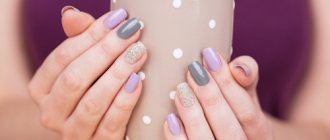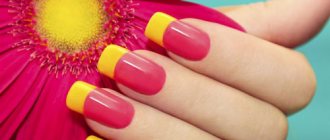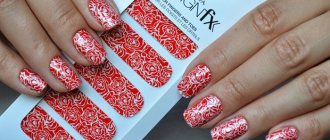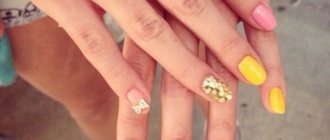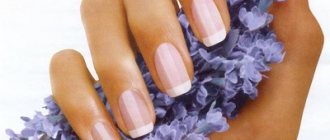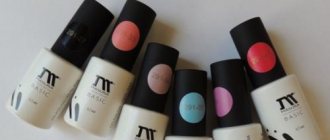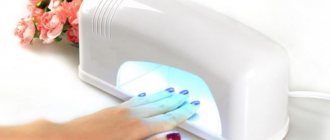Gel polish quickly peels off from the nail for several reasons: due to the fault of the master (process technology is violated, low-quality materials are used), due to the fault of the “owner” of the decorative coating (mechanical impact, shock, violation of care rules) and due to natural factors (diabetes, pregnancy, applying gel polish during the current period, taking antibiotics).
By removing provoking factors and following precise manicure technology, you can prevent peeling of the decorative coating.
There are several ways to correct the resulting flaws: completely change the gel polish, use decorations such as rhinestones, stickers, or disguise a small chip with varnish of a similar or contrasting color. The manicure will no longer be flawless, but the problem area will be hidden from others.
Why does gel polish peel off quickly from the nail: the main reasons
The reasons for the rapid peeling of gel polish from the nail may be the technician’s mistakes when performing the work and ignoring the rules for caring for the decorative coating by the girl/woman herself.
| Reasons due to the fault of the master | It's the girl's fault |
| Use of low quality materials or different manufacturers in the work | Prolonged contact with water in the first few hours after a manicure with gel polish |
| Violation of process technology - for example, improper processing of the cuticle, applying a base to the cuticle, poor degreasing of the surface, and so on | Carrying out spa treatments for hands immediately before applying gel polish: oils and steaming provide excessive moisture and increased oiliness of the nail plate |
| Applying too thick a layer of gel polish or base in the area of the anatomical location of the cuticle | Applying a decorative coating to nails that are too thin or peeling plates |
| Failure to comply with the time period required to dry each layer of materials in the lamp | Ignoring the warning that gel polish does not last when applied during menstruation |
| Ignoring the need to remove the sticky top layer | Excessively oily skin of the hands/fingers, which has not been treated beforehand - for example, oak bark decoction baths have not been taken |
In addition to the listed reasons for the rapid detachment of gel polish, it is worth paying attention to the general health of the woman: some internal pathologies provoke the occurrence of this problem even if the master performs his work strictly according to technology and using high-quality materials.
There is no need to hope for the promised result after a manicure with gel polish if the client has a history of diabetes, heart and vascular diseases, various hormonal disorders, or the woman is taking antibacterial drugs as part of the therapy.
We recommend reading the article about the difference between gel polish and shellac. From it you will learn what is the difference between gel polish and shellac, what is better and what is more harmful, and also how to extend the wearing period. And here is more information about how to do a French manicure with gel polish.
The second reason is you
- Some girls have one interesting natural feature - wet nail plates. Alas, gel polish is powerless against such a turn. Its composition is designed in such a way that it adheres better to completely dry nails. But regular polish wins in this regard and promises to serve faithfully even on wet nails.
A wet nail plate is one of the reasons for gel polish peeling.
Interesting! Sometimes a high-quality primer helps against this problem. If you apply this product in 2 layers, your nails will dry thoroughly.
- Perhaps you didn’t even realize that the root of this problem could be in your critical days. Yes, yes, the body can also be irritated by everything during this period, and it may well not accept everything new.
- Analyze whether you handle the finished manicure with enough care? Even though gel polish is highly durable, it will clearly not be ready for housework without gloves and mechanical stress. You should take special care of your hands in the first 12 hours after applying gel polish - that’s how long it will take for it to harden.
- The condition of the nails is also important as a result of the manicure. Porous, weakened or brittle plates simply cannot cope with the load of gel polish. If you suspect that this is the reason, start restoring your nails.
Manicure option for thin nail plate
Note! If the condition of your nails is not too bad, it makes sense to strengthen them with acrylic powder. This will make the plates thicker, and at the same time ensure durability of the manicure.
- But against obvious unevenness on the nails, careful sanding before applying the gel coating often helps.
Nail polishing
Why gel polish doesn’t stay on nails due to the master’s fault
Gel polish on nails most often does not stay on due to the fault of the master, although the process of performing a manicure does not present any particular difficulties, and the main reasons for the decorative coating coming off are the following violations of the technological process:
- there are remnants of microparticles of fat on the nail plate and adjacent areas;
- The base varnish is applied in too thick a layer, or its polymerization has not been fully completed (insufficient drying in the lamp);
- the free base of the nail was not sealed;
- poor quality preparation – the pterygium layer has not been removed from the plate near the cuticle;
- one of the layers (or all at once) is not dried well enough;
- The topmost layer of fixative (top) is not applied to the entire surface of the nail or lies unevenly.
Another common mistake of the master is that he uses varnishes from different ones due to different composition. Professionals recommend using base, primer, gel polish and top coat of the same brand.
Why do nails streak?
Gel polish can streak the nails and lie unevenly on the plate, and there are several reasons for this:
- the decorative coating has expired;
- loss of textural uniformity of gel polish;
- unevenness of the nail plate;
- not removing the sticky layer from the base.
It should be taken into account that any unevenness on the surface of the nail (grooves, roughness, tubercles) will be clearly visible even after applying gel polish - the coating completely repeats the relief of the plate, which leads to the appearance of stripes and uneven painting.
There are several options to solve the problem:
- It is worth preparing an ideal base for a colored coating, and this can be done using rubber material;
- before applying gel polish, gently roll the bottle with it in your palms - perhaps the pigment has simply settled, and shaking will solve the problem;
- remove the sticky layer from the base and dry the treated surface well;
- Apply both the decorative coating and the base in the thinnest possible layers and make 2 of them, thoroughly drying each in a lamp;
- apply gel polish with a drop, and then stretch it parallel to the nail (this is how you need to hold the brush).
Why did it become soft
Gel polish becomes soft even if the master fully complies with the technological process, and the reasons for this problem may be:
- weak/poor quality lamp - you should try to dry each layer of coating longer and carefully monitor the level of polymerization or change the bulbs/spirals/diodes to new ones;
- unsuitable lamp for gel polish - some brands produce coatings designed for drying only in “their” lamps;
- gel polish was applied, which is dried only in LED lamps, and the master uses a different type of lighting equipment.
The most common reason for the softness of a decorative coating is the expiration date of the material, but often there is a defect from the manufacturer.
Why does it flake?
Gel polish can begin to flake off literally in the first day after a manicure, and this problem is considered the most common, and its causes can be classic violations on the part of both the master and the girl/woman:
- the pterygium (a thin layer of skin on the nail near the cuticle) was poorly removed;
- the nail and the entire area around it were poorly degreased;
- the base, gel polish and top coat were applied in too thick layers and, as a result, did not fully polymerize;
- the top coat is applied unevenly;
- immediately after the manicure, the nails are in water;
- when working with any aggressive liquids, the girl/woman does not use gloves;
- manicure was applied during menstruation, pregnancy or in the acute phase of hormonal disorders.
To prevent gel polish from peeling off, you should remember three “don’ts”:
- the day before you cannot perform spa treatments or do oil manicures;
- in the first 10 hours, you should avoid prolonged dishwashing, hand washing and general cleaning;
- Using detergents, cleaners and any other aggressive liquids without gloves can cause the decorative coating to peel off.
Why does acrygel come off from nails?
Acrigel may come off from nails for the following reasons:
- during the preparation of the natural plate, the master cleaned the pterygium poorly;
- Initially, the cuticle was removed using a softener, and its particles remained on the nail;
- acrygel is placed too close to the cuticle and lateral skin ridges;
- the material is too liquid or too dry;
- Old ultraviolet lamps are used to dry the coating, but they do not polymerize the coating properly.
Also, acrygel can come off the nails if it is applied to a plate that is too long - the pressure on the tips of the nails increases, and the decorative layer begins to “spring.” In this case, the detachment of the material begins from the sides or directly at the cuticle itself.
Incorrect gel polish application technique
The reasons why gel polish does not stay on nails are often related to the level of professionalism of the artist. In order for the product to stay on the nails as long as possible, it is necessary to follow the coating technology.
Incorrect gel polish application technique
The reason for gel polish peeling off a couple of days after its application may be:
- Cuticle. When creating a manicure, first of all, you should push back the cuticle and get rid of the pterygium - the thin lower layer of the cuticle that grows onto the nail. The gel polish will not adhere well to the cuticle and will soon peel off.
- No sanding. Each nail must be polished using a file (buff).
- Oily surface. The nail plate requires degreasing. To do this, apply a special product to a lint-free napkin and wipe each nail well with it. Alcohol or acetone can be used as a degreaser.
- Saving on primer. To ensure good adhesion between the nail and the varnish, you should use a special primer - primer. There are two types of primers: acidic and acid-free. More gentle on nails is an acid-free primer or ultrabond. It kills harmful bacteria, additionally degreases the nail surface and removes excess moisture.
- Applying gel polish in a layer that is too thick.
- No sealing of nails. When painting, each layer of varnish must be “sealed”, i.e. Apply the product to the cut of the nail plates.
- Poor drying. After applying gel polish, nails must be thoroughly dried. Drying time depends on the lamp power.
Drying gel polish
Attention! When choosing a lamp for manicure, preference should be given to models with light-emitting diodes (LED). Ultraviolet lamps can have negative effects on the skin and eyes.
- Poor quality gel polish. A cheap product from China will not stick to your nails.
- Using a base and top product in one bottle. In order for the manicure to last as long as possible, before using the gel polish itself, you need to apply 1 layer of base gel to the nail. The top coat is the finishing coat; it is applied on top of the shellac, fixing it and protecting it from harmful influences. After applying any product, nails should be dried under a lamp. If you use a 2 in 1 base and tone, the quality of the manicure will be worse than when using two separate products.
- The use of single-phase gel polishes without top and base.
- Overdrying of the nail plate. To fix this, you need to regularly use oily cuticle care products. Sea buckthorn, coconut, cocoa oil, etc. are suitable for nails.
- Expired gel polish.
- Using manicure products from different lines.
Gel polish
When choosing gel polish, it is necessary to take into account not only their durability, but also the method of removal. The most convenient and safest option for getting rid of old varnish is soaking. It is recommended to entrust the removal of the coating by cutting to professionals. After improper filing, nails become brittle and thin. You only need to file off the top so as not to harm the nail. It is safer to use gel polishes, which require soaking your nails to remove them.
Why does gel polish come off the nail for natural reasons?
If all the technological subtleties of the process are strictly observed by the master, then you need to look for the reason why the gel polish comes off the nail in a woman/girl:
- Excessive hydration . This is the name of a condition in which a person's palms become very sweaty. A humid environment is a priori not conducive to a high-quality and durable manicure, so increased sweating leads to the gel polish coming off within 3-5 days after visiting the master.
- Too thin nail plate . This may be an individual characteristic of a woman or the result of using a manicure with gel polish for too long and constantly filing off its layer.
- The presence of tubercles or any irregularities on the surface of the nail plate . They reduce the quality of the “adhesion” of the decorative coating and the nail. The problem is solved simply - the master levels the surface with the thinnest layer of gel, which at the same time becomes the base coat.
Natural reasons for gel polish coming off the nail include hormonal disorders in a woman’s body, which can occur during pregnancy, diabetes, or current menstruation. Antibacterial drugs (if they are taken systematically for therapeutic purposes) and antidepressants accelerate the process of rejection of decorative coating.
Watch the video about the reasons for gel polish adjustment:
Why does gel polish peel off at the tips of my nails?
Gel polish peels off at the tips of the nails for several reasons:
- At the end, the applied layer simply did not seal. This happens especially often when working with short nails, but if the master does not paint the end of the plate, then peeling of the decorative coating is almost guaranteed.
- The rule of abstaining from water treatments for 2-3 hours after a manicure with gel polish is not observed. Professionals recommend that before visiting a specialist, you should refrain from washing dishes and any work with water for 3-4 hours.
- A woman independently files the tip of a nail with gel polish applied to it. The layer that sealed the end of the plate is removed, the coating begins to crack, which leads to its detachment.
If it moves away from the cuticle
Gel polish comes off the cuticle, most often due to violations by the master of the technology of the manicure process, in particular:
- the cuticle was not completely trimmed before applying the base and decorative coating;
- the plate was not cleared of pterygium;
- The gel polish lay down near the cuticle like a roller, a “step”.
The listed factors provoke the formation of voids between the gel polish layer and the plate or cuticle; air bubbles accumulate in them, which leads to detachment of the coating.
Why does it wear off on the tips of the nails?
The gel polish on the tips of the nails often wears off, but this happens only for mechanical reasons:
- cleaning of the house/apartment is carried out with aggressive agents and without protective gloves;
- washing dishes using detergents and steel wool;
- using too aggressive body scrubs;
- visiting a bathhouse or sauna earlier than 5 days after a gel polish manicure.
These provoking factors can be easily eliminated; you just need to follow the rules for caring for nails with gel polish to avoid abrasion of the decorative coating on the tips.
Remover residues in the cuticle area
When using a remover to remove cuticles and pterygium, it is important to thoroughly remove any residue before further application of the coating. The remover may contain lanolin and glycerin, and these are fat-containing components that interfere with the further tight fit of the artificial material.
In addition to the remover, the master could use a hemostatic agent for cuts. Its remains are another cause of detachments.
To remove them from the surface of the plate, use a degreaser and a lint-free cloth. You can put a napkin on an orange stick to carefully work on the areas under the cuticle and the overhanging part of the side ridges.
Why does shellac quickly peel off like a film?
Shellac can quickly peel off and come off like a thin film, not only due to the fault of the master; often the problem lies in:
- using completely incompatible finishing and color coatings;
- applying a layer of top (fixing) to poorly dried gel polish;
- incomplete baking (polymerization) of coating layers;
- thickening of the top, the end of its shelf life.
In the above cases, it is the top coat that will peel off as a thin film, but the color layer will remain unchanged. True, the latter will become duller and will be more susceptible to mechanical/chemical damage.
Chips on nails with gel polish: reasons
The main reason for chipping gel polish on nails is mechanical damage: the tip of the nail receives blows, a woman/girl uses her nails as a screwdriver, a picker, or even tweezers. Despite the declared strength of gel polish, such use of it leads to chips - they can form at the tip of the nail, on the sides, and in close proximity to the cuticle.
It is not the master’s fault for chips; the absence of such damage can only be ensured by a girl/woman by following the “safety precautions” of wearing a manicure with gel polish.
If the gel polish on your nails chips, how to fix it, stick it on
There are several ways to fix or glue gel polish after it has chipped off on your nails: decorate the problem area with rhinestones or other colors of decorative coating, or completely replace the gel polish.
The easiest way to do the last option is to cut off the existing coating, degrease the surface of the plate, apply all the necessary layers one by one and dry with great care in a lamp. It is highly advisable to find out the reason for the peeling/chipping of the gel polish, and if this happened due to the fault of the master, then you need to take into account the mistakes and prevent their recurrence.
Watch the video about what to do if the gel polish breaks off:
A less labor-intensive, but very effective way to mask chips/flaking with another varnish. It is advisable if the problem has formed near the cuticle. In this case, you can draw a stripe with a contrasting color of varnish or create any shape, do a French manicure or a “moon smile” (the choice depends only on the location of the chip). You just need to apply several layers of coating and wait for each of them to dry completely.
If the decorative coating has broken off on the side of the nail plate or near the cuticle, then this place can be disguised with rhinestones, appliqué, or shiny spraying. But this option is only possible if the volume of the problem area is small; a layer of transparent gel will need to be applied under the rhinestones/stickers.
Important: it is advisable to correct chipped gel polish on nails using “camouflage” methods only if less than 10 days have passed since the manicure was performed. After the specified period, it will only be possible to completely remove the decorative coating and perform the procedure again.
How not to ruin your manicure when applying it
- Number of layers. For weak nails, increase the number of layers of base polish rather than color.
- Single-phase varnish lasts better if applied to a transparent base.
- After degreasing, you should not touch your nails. You cannot “touch” the condition of the gel polish after drying.
If the manicure is done according to the rules, the varnish will last up to 3 weeks.
If gel polish peels off, how to fix it at home
If the gel polish has peeled off, and it is not possible to visit a specialist, then you can correct the defect yourself at home and even without special tools or equipment, for this it is recommended:
- Use a file to sharpen the problem area - you need to remove the sharp edges of the chip and “soften” them a little.
- Degrease the surface of the “hearth”.
- Apply a drop of varnish that best matches the color of the existing decorative coating (you can also play with contrast).
- Use a brush to evenly distribute the layer of varnish and dry it - you will have to wait 15-20 minutes without a lamp.
- Apply a second coat of varnish and dry again for 20 minutes.
- Completely cover the nail plate with a transparent sealer.
Degrease the surface of the “hearth”.
Apply a drop of varnish that best matches the decorative coating. Dry for 20 minutes. Completely cover the nail plate with a transparent sealer. This method of “disguising” will not return the manicure to its former ideality, but it will make the nails neat and “postpone” the time of visiting the master for mandatory correction.
Why does gel polish last a long time on nails, how to extend its life
Gel polish lasts a long time on the nails, because the process of performing a manicure involves filing off a layer from the surface of the plate, completely leveling it, degreasing and subsequent drying of each material used. You can strictly extend the period of wearing it by observing certain conditions:
- dry each applied material completely, this also applies to the primer;
- base, gel polish and top are applied exclusively in thin layers;
- Before applying any material, you need to “squeeze” the brush - this is done by pressing on the edge of the bottle;
- the applied product must cover the nail plate completely;
- You should work simultaneously with a maximum of 2 nails, which will prevent the gel from spreading and penetrating under the side skin folds;
- strictly adhere to the drying time of the material in the lamp;
- Be sure to “solder” the ends.
Example of applying gel polish
These conditions must be observed by both the master and the girl/woman herself if she gives herself a manicure with gel polish at home.
How long does it last normally?
Normally, gel polish lasts on nails for at least 3 weeks. There are women whose manicure remains flawless for up to 6 weeks of wear - their own nails grow slowly, the rules for “exploitation” of the decorative coating are followed.
Means for extending the period
The main means for extending the wearing period of gel polish are:
- Conducting proper preparation. The day before visiting the master, you should not do general cleaning, do laundry by hand, take a hot bath, or visit the sauna/bathhouse. It is recommended to categorically avoid contact of nails with aggressive liquids during this time period.
- Proper pre-treatment of nails. The best option is to perform a manicure using a special device and a cutter. The most important thing is complete, high-quality removal of the cuticle and pterygium (skin film on the nail plate). It is necessary to reduce the likelihood of skin injury to zero - if there are bruises or hematomas, it is impossible to apply gel polish properly.
- Carrying out high-quality grinding of the plate surface. Manipulation is performed with a special buff; it is especially important to pay attention to the area around the cuticle and nail folds. If the buff does not allow you to thoroughly treat these areas, then you can use a soft nail file. When choosing the latter with a highly abrasive surface, there is a high chance of damaging the skin around the nail plate.
- Degreasing. This is a mandatory stage in manicure, on which the adhesion of the decorative coating to the nail depends. The product is applied to the plate with a napkin, the root and sides are treated especially carefully. Experts recommend using special degridation solutions at this stage - primer, ultrabond. They are needed to be on the safe side, even if your hands have not been in contact with water, and in case of increased sweating, they are applied in two layers.
- Compliance with application technique. The base should lie in an even layer without bleeding or getting on the cuticle, and if this happens, then the “excess” is removed with an orange stick before placing the nail in the lamp. The thickness of the applied layer should be medium, you need to work with the material quickly so that it does not spread. It is important to “seal” each layer at the end of the nail.
Technique for applying gel polish
It is important to properly care for your manicure. For example, when working in the garden or cleaning/cleaning/washing with aggressive agents, you should use rubber gloves. You should avoid keeping your nails in water for a long time only for the first 2 hours, and you should not go to the bathhouse/sauna only for the first 24 hours. It is important to protect your nails from mechanical damage - even a slight blow to the decorative layer will cause chipping and delamination.
How to apply gel polish correctly so that it sticks well and does not chip
The algorithm of actions has long been worked out by real experts, so if you intend to do this professionally, it would be a good idea to take special courses. This is the only way to truly learn the secrets and hone your skills in practice. The practical experience of the masters will be useful, as well as a trained eye for possible mistakes of beginners. Even if you use the acquired knowledge exclusively on yourself and your loved ones, it will help you significantly save on a professional procedure. You can find out which antifungal varnish is best in this article.
Main nuances of application technology:
- High-quality products and a lamp are half the success of preventing your nails from peeling and cracking. As mentioned earlier, it is advisable to use products of the same brand to avoid rejection and separation of the gel even during application. If colored gels can be bought cheaper, then the base and top must be of the same company and of good quality.
- The gel must be fresh. The old coating becomes thicker and unsuitable for manicure.
- Preparing the nail plate is an important point. It must be cleaned of cuticles and pterygium (the thin layer adjacent directly to the nail), sanded and degreased. The edge of the nail also needs to be trimmed a little for better adhesion to the material.
- If before the procedure you had a regular “water” manicure or simply had water treatments, your nails need to be dried a little. A special primer is used for this.
- Excessively thin and brittle nails must be strengthened with a special gel. Before purchasing it, be sure to make sure that it is washable, otherwise you will have to file it off and your nails will be significantly damaged.
- Each layer must be sealed and dried in a lamp. If the technology has been violated, you can forget about the quality of the coating.
- The gel layer must be thin for polymerization to be successful.
Despite the fact that universal three-in-one gel varnishes have appeared on sale, it is single-phase products that provide the greatest strength and durability. This will slightly increase the total cost, but the quality will be high.
An important point will be the method of removing the old coating. It is best to choose soluble varnishes so as not to injure your nails with aggressive filing. Moreover, you should not remove the coating yourself. Most masters sooner or later encounter examples of such “savings” and the results are usually disastrous.
The advent of gel polish, thermal nail polish and a fundamentally new coating technology have made a real revolution in the art of nail art. Applying gel polish at home is gaining popularity.
Video for you: how to apply gel polish correctly
Prevention and protection of a good manicure
Unusual types of varnish have long become fashion favorites, and one of them is mirror varnish.
As stated earlier, it is necessary to use protective gloves when performing any household work. If possible, protect the coating from contact with high temperatures and chemicals. Despite its durability, even the highest quality varnish will crack if used carelessly, so caution will be useful.
You will definitely like gel manicure for its durability and the ability to create real masterpieces of nail aesthetics. At the same time, in order for such a miracle to remain impeccable for a long time, you must follow the basic rules and carefully monitor the condition of your nails. It will be a great help to use protective gloves when doing housework. Knowing the main reasons and nuances of protecting the applied coating, you can extend the life of your manicure for a long time. The tips in our article will help you with this. We also recommend that you read reviews of Vinylux nail polish in this material.
What to do if shellac is peeling off
If, even if the process technology is followed and natural causes are excluded, the shellac peels off, then it is worth carefully studying the materials and equipment that are used in the work.
You need to pay attention to:
- manufacturers of base, gel polish and top coat - it is better if it is not China, but well-known brands;
- use coatings for step-by-step application, rather than universal “3in1” or “2in1” options;
- bottles with base, gel and top should be stored in a dark place and strictly monitor their expiration dates;
- control the condition of the “consumables” - a greasy layer may form on the buff, and worn files will leave cuts on the surface of the nail;
- change lamps in lighting equipment - according to the instructions, this is done once every 3-6 months, monitor the power of the device;
- You need to change the cutter attachments on a manicure machine once every 2-3 months, monitor the condition of the machine - it can become loose over time, which causes strong vibration.
We recommend reading the article about what you need to know when choosing a lamp for gel polish. From it you will learn why you need a lamp for gel polish, how it works, and how to choose a lamp for drying gel polish. And here is more information about how to remove shellac at home.
Gel polish is used for long-term manicures, but sometimes after just a few hours/days the decorative coating comes off, and chipping and delamination can occur. This can be avoided by following the process technology, proper care after applying the decorative coating and the right choice of materials and equipment for the work.
